This post contains affiliate links, which means I may earn some money if you click on one. Don't worry, there is no additional cost to you. Thank you for supporting my blog.
The gardening endeavor I was most excited about last year was growing a pumpkin on a trellis. One of the advantages of having a plot at a community garden is you have an unintended audience. There are the other gardeners who tend a plot there, and my community garden plot is located at a public park. There is a farmer’s market held there weekly, and people sometimes wander over to check out the gardens. So when I read about growing a pumpkin vertically, on a trellis, in Mel Bartholomew’s All New Square Foot Garden Book, I fell in love with the idea.
Growing squash and melons vertically have many benefits; the wow factor is just a small perk. By growing pumpkins, squash, and melons vertically, you can make the most of your space. These plants usually spread out all over the garden. Though last year was my first time growing pumpkins and squash, I have visited pumpkin patches before, and the vines take up a lot of space. If you have limited space available to grow vegetables, I highly recommend growing “UP”.
Disease was also less of an issue. The only disease problem I had with the vertical spaghetti squash plant we grew last year was a white mildew, (which I think was powdery mildew). If it was grown on the ground, I am not sure I would have had a harvest.
There were three squash varieties I tried growing vertically last year; a small Sugar Pumpkin, spaghetti squash, and a zucchini plant. The only one I had great success with was the Spaghetti Squash.
Zucchini
The zucchini plant was a disaster. In my mind I was envisioning a plant that looked like a cucumber plant, which grew on a vine and grew easily up a trellis. (I am not kidding when I said I was a gardening newbie). I think there are a few varieties that you can buy that will climb, but that was not the type of zucchini plant I tried to grow. (I did not do my homework on this one).
Most zucchini plants are bush plants and need a lot of room. (I did read you can find zucchini plants that are climbers, such as the Black Forest Zucchini, but that is the exception, not the rule). So, I did not leave a lot of room for the zucchini plant, I planned on growing 2 and left only two square feet, (2 squares), for each. As a result, one plant did not even produce any zucchinis. I only harvested a few zucchinis from the second plant.
The other mistake I made with my zucchini plants was transplanting them. I started the seeds indoors, and thought I was getting a “head start”on growth. However, it seemed to take a long time for the plants to recover after transplanting. I later read that they do not transplant well. So I learned three valuable lessons last year for my zucchini plants; don’t waste a trellis, give the plants a lot of space, and plant the seeds directly into the ground.
Pumpkin
I would not call the small sugar pumpkin a complete failure because it did grow successfully up the trellis, which was pretty awesome. The plant only produced one pumpkin though. I am not sure why, my best guess is I did not give it enough room. I grew it up the same trellis as the spaghetti squash. Though I planted both seeds into the ground at the same time, the spaghetti squash completely took over. I would say the vine on the trellis was 75% spaghetti squash, and 25% sugar pumpkin. But I only wanted one pumpkin for Lily to harvest. I thought it would be fun for her to watch it grow. I anticipated harvesting it in the fall and painting a face on it, or decorating it. So only having one pumpkin grow was not a huge disappointment.
The part that was annoying was the pumpkin developed on the ground instead of on the trellis, which lessened the WOW factor. But it gets worse; when the pumpkin looked ready to harvest, we were dismayed to discover a hole in the bottom with a worm crawling out of it. So we were not able to harvest our ONE pumpkin. I am not sure what happened, maybe it could have been prevented if we harvested it earlier. Or maybe that is just part of the risk in having pumpkins ripen on the ground. I can’t call the “vertical pumpkin plant” a success when we did not have a successful harvest.
This year I am going to grow two pumpkin plants up a trellis, increasing my odds significantly.
Spaghetti Squash
One of the greatest successes in my garden was Spaghetti Squash. In some ways it was one of the easiest plants to grow. The most difficult part was setting up the trellis. I planted that seed directly into the ground, so there was no indoor maintenance before the growing season. The seed was not purchased; it was a seed that Lily and I literally scooped out of an organic spaghetti squash we bought at the store. (Note: this is not an ideal situation. You are supposed to purchase seeds from a trusted source to make sure the plant is “disease free”). This was an experiment, one I did not fully expect to work. I was pleasantly surprised.
The Spaghetti Squash plant thrived for most of the summer. It did very well until the powdery mildew came. It started at the bottom of the plant and worked its way up. However, the plant was well established when the powdery mildew made its appearance. The squash were already half way developed, and continued to ripen fine even as the leaves dried up and fell off the plant. (It was pretty sad looking at the end, but I was able to harvest all the spaghetti squash and they were fine). If this plant was sprawled over the ground, I am not sure it would have survived. The plant would definitely have been more vulnerable on the ground. (I later read that the trick is to stay ahead of the mildew.
I should have trimmed the leaves off that were bad right away, and been more proactive. I also did not fertilize, I simply amended the soil with extra compost. Many say that makes a big difference in the strength of the plant). We got to watch 5 Spaghetti Squash grow, and it was very exciting to watch. We were able to harvest all 5 of them, and shared a couple with friends.
I have a good feeling that this year we will get an even bigger harvest because I am going to fertilize, and I have a plan in place to attract more bees. I am going to plant some Borage plants, possibly next to the vertical trellises. The bees LOVE Borage, and they are tall and beautiful plants. (The flowers are edible too, how cool is that)? I am “hoping” to have more flowers on the Spaghetti Squash plant pollinated by the bees. I am not sure if this will increase production or not, but it definitely could not hurt. I am also thinking about hanging some dill plants on the trellis to repel a pest that I think may have spread the powdery mildew.
These beetles which I think were “cucumber beetles”, showed up around the same time the powdery mildew. I know correlation is not causation, maybe they had nothing to do with the spread of the mildew. However they can spread disease, such as bacterial wilt, so I did not like their presence in the garden. (Sometimes we picked them off by hand, but that is tedious, and they just came back).
If anyone has any experience with these beetles, please let me know what works to prevent them. Here is some basic information I found about these beetles – http://articles.extension.org/pages/64274/managing-cucumber-beetles-in-organic-farming-systems. This is something I need to do more research on.
So that was our experience with vertical gardening. It was a lot of fun, and I look forward to growing pumpkins, squash, and melons on a trellis this year!!
Have you grown squash or melons vertically? What as your experience?


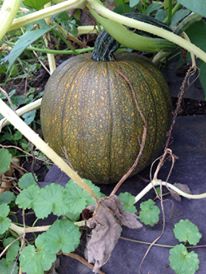
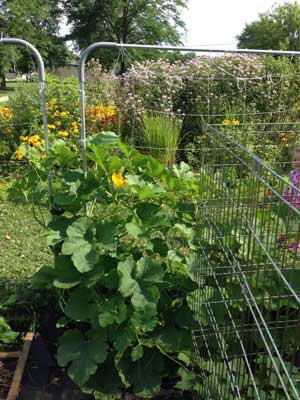

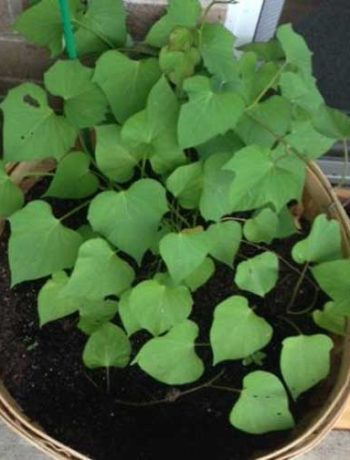
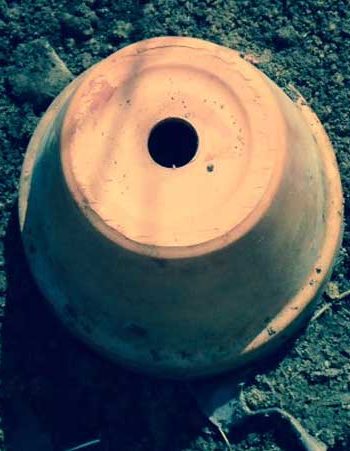
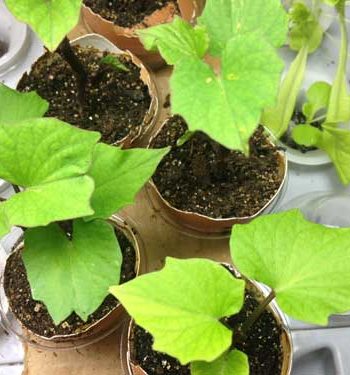
No Comments